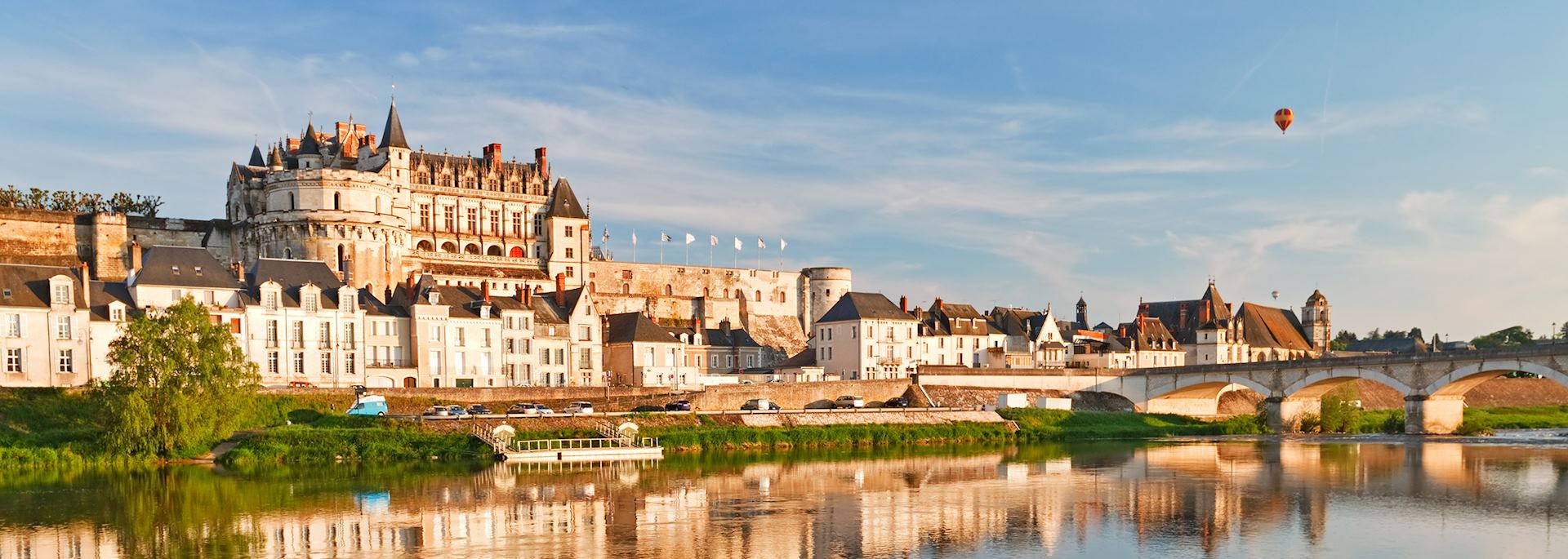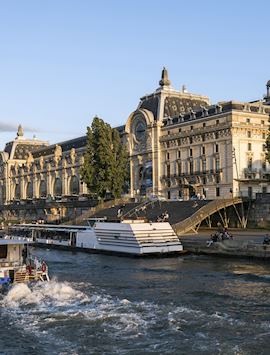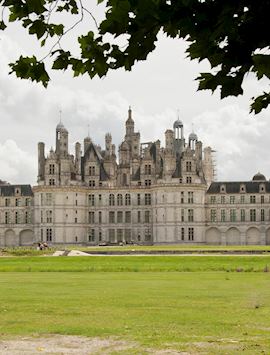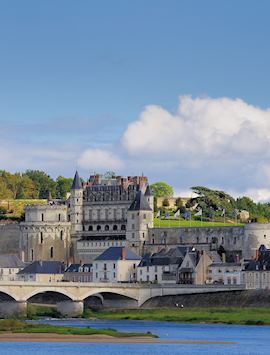By France specialist Aislyn
When France’s Renaissance kings wanted to escape the noisome urban sprawl of Paris, it was the Loire Valley they chose as their retreat. Where the French royalty went, their courtiers followed for fear of losing partiality, building chateaux close to the king’s.
They were all attracted by a valley graced with thick forests that abounded with game, plentiful water from the country’s longest river and easy-to-mine limestone for building. That abundance made it easier for the monarchs and their courtiers to build the fantastically turreted chateaux that still dot the valley.
Undoubtedly, the kings were also attracted by the valley’s vineyards. Nicknamed 'the Garden of France', this remains one of the country’s most diverse wine-growing areas, producing not just reds, whites and rosés, but also sweet dessert wines and sparkling vintages that rival those from nearby Champagne.
Things to see & do in the Loire Valley
Amboise
Perched on the banks of the river in the middle part of the valley, Amboise is just two hours from Paris and a short drive to many of the chateaux for which the region is known. With a wide selection of cafés and restaurants, and some of the area’s best hotels, it makes a convenient base for exploring the valley.

However, there’s more to Amboise than just a good locale, and I always take a few days to explore the town itself. Its narrow streets, half-timbered houses and turreted castle all recall the era when it was the home of both François I and Leonardo da Vinci, whom the king enlisted to help bring about France’s Renaissance.
Sitting high on a rocky escarpment overlooking the Loire River, the Château d'Amboise is proof of the affection that kings held for the town. Both François I and Charles VIII were raised here and many other French kings made it their summer retreat.
Not many of the chateau’s original buildings remain, just one wing and the chapel in which da Vinci is thought to be buried. The mishmash of styles, blending Renaissance elegance and Gothic grandeur, is unified by the creamy white limestone walls and black slate roofs. The time-darkened ramparts provide views of the river and city below, and on Saturday nights there’s a light show over the castle.
Nearby, you’ll find the Château du Clos Lucé, a small red-and-cream-brick manor topped with sharply peaked gables. Renaissance polymath Leonardo da Vinci spent the last three years of his life here, at the invitation of François I. Today, the building houses a museum devoted to the life and works of Leonardo, including a copy of the Mona Lisa, painted by the artist himself. It also exhibits more than 40 models built based on his designs.
Sundays, the town hosts one of the region’s largest markets. Stalls set up along the banks of the river, selling everything from produce to live birds.
Château de Villandry

Precise, formal and geometric — yet somehow still exuberant — the gardens at the Château de Villandry are one of the places I most like to visit in France.
Villandry is considered the last of the great Renaissance chateaux, built by Jean Le Breton, finance minister and ambassador to Italy for François I. During his time in Italy he fell in love with the formal style that was the rage there and added six different gardens to his own castle when he returned to France. Successive owners altered the gardens over the centuries, but their restoration started in 1908.
The Renaissance style accentuates symmetry and precision. A squad of gardeners trains the hedges into dense green borders in fanciful shapes ranging from simple squares to Celtic-style knots and labyrinths. These frames are then filled with a vast variety of planting, chosen to create a succession of blooms during the growing season: yellow daffodils in the spring, creamy pink roses in early summer, fragrant lavender in the midsummer and autumnal red-veined beet greens.
The gardens are huge — roughly the equivalent of nine football fields — so I always allocate a whole day to wander through them. There’s something new to see every time I visit, especially with a private guide. The deep symbolism inherent in the gardens’ design isn’t immediately obvious to a modern mind without an interpreter.

For example, the Jardin d’Ornement (Ornamental Garden) depicts the four types of love with the language of flowers and the shape of the hedges. Tragic love is represented by dagger-shaped hedges and blood-red blooms, while passionate love is signified by hedges shaped like broken hearts.
The Jardin des Simples (Kitchen Garden) is more practical than symbolic, but no less beautiful. It recreates the monastic style of gardens from the 16th century — nine squares, each describing a different motif. The precise layout, carefully outlined by white gravel paths, highlights the sculptural beauty and vivid hues of vegetables. In this careful setting the blue-green fans of leeks, deep-purple knots of cabbage and lacy froth of fennel all seem elevated from simple staples to works of art.
The chateau itself is a little less interesting than the gardens, but still lovely. Tours of the interior include some rooms furnished in Renaissance style and others that retain their Art Deco stylings from the era when the gardens were first restored.
Château de Chenonceau
Built on an arched bridge that spans the Cher River, the Château de Chenonceau was shaped by a number of powerful women residents, earning it the nickname the Château des Dames (the Castle of Women).
The original construction in the early 16th century was overseen by Katherine Briçonnet, who was married to Thomas Bohier, Chamberlain to Charles VIII. Diane de Poitiers took possession in 1547, the chateau gifted by her lover, Henri II. She created the distinctively arched bridge and many of the formal gardens.

After the king’s death, Henri’s widow, Catherine de Médicis, forced de Poitiers out. During her tenure there, she ran the kingdom from the chateau’s Green Cabinet. She extended the grand gallery to cover the entire bridge. Her extravagant parties, held in the checkerboard-floored room overlooking the languid river, were a focal point for social events during the era.
De Médicis’s daughter-in-law, Louise of Lorraine, spent widowhood here after her husband, Henri III, was assassinated in 1589. She indulged her grief wildly for the remainder of her years, only wearing all-white widow’s weeds (white was considered the proper shade of mourning for queens). She also turned her bedroom into an altar of death, covering the walls with black tapestries and hanging her bed with black draperies, all of it covered with macabre skull and crossbones motifs. A portion of the morbid room remains preserved for visitors.
More recently, the chateau became a vital conduit for Jewish refugees escaping the German occupation in World War II. The River Cher marked the border of Nazi-occupied France and so one end of the house was held by the Germans and the other opened into Free France.
The palace also houses tapestries, ornately ornamented furniture and a large collection of paintings by many important European artists of the 15th and 16th centuries, including Rubens, Ribalta, Nattier, Veronese, Van Dyck and Zurbarán.
The chateau’s long list of attractions — history, gardens, art and architecture — draws many visitors. A private guide can help you avoid the crowds and bring the complex history to life.
Last time I visited, I took a boat ride under the bridge. Sipping Champagne as I drifted lazily down the languorous river was a peaceful way to avoid the crowds and appreciate Diane de Poitiers’s magnificent vision.
Bike tour through a wine cellar

The bedrock of the Loire Valley is tuffeau, a fine-grained limestone that’s easy to mine and sculpt. It has been mined extensively over the centuries, especially to build the region’s many chateaux. The quarries left behind are thermally stable regardless of season, staying at an ideal temperature and humidity for storing and aging wine.
They’re also vast — huge caverns that seem to go on forever into the echoing darkness. At the Bouvet-Ladubay cellars, they’ve solved this problem by offering bicycle tours.
The vintage bicycles are all brightly painted — mine was gold — and you need to wear a headlamp to light your way through the dark cavern. My tour guide led me through aisles lined by wooden barrels, bound by black bands, as well as huge crates of bottles held at Escher-like angles by huge machines.
The guide explained that the bottles must be rotated every three hours during part of the process to prevent improperly settled sediment from spoiling the wine. Before the days of automation, the bottles were turned by hand, a never-ending process for a producer this large.
The tour is followed by a tasting of the different sparkling wines that are aged here. I was most fond of the Bouvet Brut Zéro, a lively wine with notes of citrus. I’m a wine enthusiast rather than a connoisseur, but I could still discern the mineral scent of the cave in the taste of the wine.
The atmosphere in the caves is conducive to wine, but chilly for humans. I suggest dressing warmly if you visit.
What to eat & drink in the Loire Valley

The Loire Valley produces every category of wine. It was one of the last regions to be affected by phylloxera, the root-rotting louse that infected and destroyed most of the Old World vines in the late 1800s. It was also one of the last to recover, which means that it’s both less well-known and less crowded than the more popular regions like Burgundy and Bordeaux.
The area boasts 69 Appellation d'Origine Protégée (AOP) wines. The French government strictly regulates the production of wines bearing the protected AOP name, ensuring high quality and consistency. Exploring the area’s vineyards and vintages is one of my chief pleasures when I visit the Loire Valley.
The riverine farmland produces more than just grapes. The flora also provides fodder for goats that produce particularly rich milk, which is made into chèvre. Many of the varieties of goat’s cheese, including Crottin de Chavignol, are protected by AOC designation, which is similar to AOP but intended for food.
Versatile chèvre comes in a variety of shapes, including a truncated pyramid. Legend has it that the cheese used to be served in a full pyramid, but Napoleon lopped off the tip in anger because it reminded him of his defeat in Egypt.
The Loire’s thick forests also provide a bounty of game. Wild boar, duck, venison, pheasant and rabbit all appear on local menus. You can also find rillettes, a dish made of meat that has been braised in white wine until it falls apart under the slightest touch. The meat is then shredded and mixed with rendered fat and chilled, then spread over bread. Usually rillettes is made from pork, but recently I tried duck rillettes. The meat was rich, autumnal and meltingly tender.
Where to stay in the Loire Valley

The Manoir les Minimes is a 17th-century former convent that’s perched on the bank of the Loire River in Amboise. The generously sized rooms are decorated in tones of cream and gold, and filled with light from the many white-shuttered windows. Every room has a view of both the river and the Château d'Amboise. Tall people should be careful not to book rooms on the top floor, where the low exposed beams could pose a hazard.
Covered in ivy and nestled in an extensive parkland estate, the Domaine des Hautes de Loire seems like a castle in a storybook kingdom. The converted hunting lodge is surrounded by manicured grounds with hiking paths, stands of trees and three fishing ponds, presided over by flights of black and white swans.
Best time to visit the Loire Valley
The chateaux are open for visitors year-round, but the gardens can get crowded in the hot months of July and August. Instead, you might consider visiting in May and June to see the spring blooms or in September to enjoy the fullness of late summer.
Start planning your trip to France
Start thinking about your experience. These itineraries are simply suggestions for how you could enjoy some of the same experiences as our specialists. They're just for inspiration, because your trip will be created around your particular tastes.
View All Tours in France




